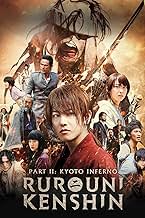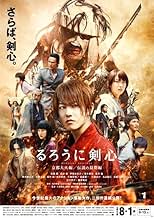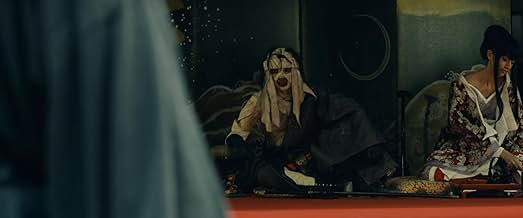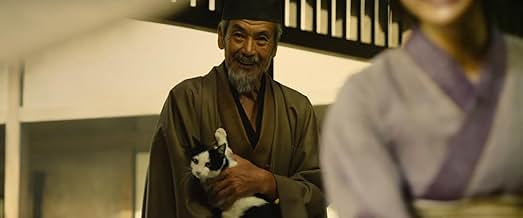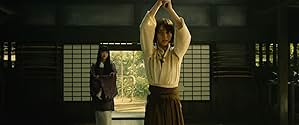AVALIAÇÃO DA IMDb
7,5/10
19 mil
SUA AVALIAÇÃO
Kenshin Himura enfrenta o malvado Makoto Shishio, que está tentando derrubar o governo Meiji. O destino do país está em jogo quando Kenshin pega a espada que ele jurou nunca mais usar.Kenshin Himura enfrenta o malvado Makoto Shishio, que está tentando derrubar o governo Meiji. O destino do país está em jogo quando Kenshin pega a espada que ele jurou nunca mais usar.Kenshin Himura enfrenta o malvado Makoto Shishio, que está tentando derrubar o governo Meiji. O destino do país está em jogo quando Kenshin pega a espada que ele jurou nunca mais usar.
- Direção
- Roteiristas
- Artistas
- Prêmios
- 1 vitória no total
Takeru Satoh
- Kenshin Himura
- (as Takeru Satô)
Avaliações em destaque
I have some complaints with the first Rurouni Kenshin but this movie finally answered me. I have to attribute it to the fact that the movie already employed the most celebrated villain of Rurouni Kenshin, *drumroll* Makoto Shishio.
One aspect where the first movie failed, in my opinion, is its failed attempt at comedy. The manga/series was injected with comical scenes and lines and as much as the first one tried, it failed. However, with Kyoto Inferno, they have pulled it through. This burden mainly fell on Munetaka Aoki (Sanosuke Sagara) and fortunately, he was successful to elicit some laughs.
If there's anything which cemented this film's success as an adaptation, it would have to be on the character actors. The movie gave life to the characters which we only once saw in animated form. Even Makoto Shishio's ruthlessness, albeit covered in plaster, was very visible. Takeru Sato deserves his role. He gives out not only the Kenshin physique, he knows how to give the Kenshin aura...the playful yet skillfull Battousai. The most dangerous member of Juppon Katana (Shishio's hired assassins), Soujiro Seta, was brought to life courtesy of Ryunosuke Kamiki (probably with the most well-recognized filmography in this group). Everyone gave justice to the roles the were playing.
The movie was perfect in all its aspects. Don't take that too literally of course, but for someone who's a fan of the series, I can safely say that they did justice. They made some deviations from the source material, but they're harmless nonetheless. There's room for error but one cannot discount how the movie successfully made a good product. The soundtrack was very, very registrable and consistent that it will give the eerie feeling.
The fight scenes were well-choreographed it looked like they were literally dancing. The movie incorporates all essentials of a Rurouni Kenshin fight...from the speed, to the agility, to the technique. It had momentous fight scenes its hard to choose which one is the best.
And the best is yet to come as Kenshin Himura will still battle it out against Aoshi Shinomori, the Juppon Katana (with emphasis on Soujiro Seta), and ultimately Makoto Shishio. Kyoto Inferno left a good ending to what will be a legendary beginning in The Legend Ends.
One aspect where the first movie failed, in my opinion, is its failed attempt at comedy. The manga/series was injected with comical scenes and lines and as much as the first one tried, it failed. However, with Kyoto Inferno, they have pulled it through. This burden mainly fell on Munetaka Aoki (Sanosuke Sagara) and fortunately, he was successful to elicit some laughs.
If there's anything which cemented this film's success as an adaptation, it would have to be on the character actors. The movie gave life to the characters which we only once saw in animated form. Even Makoto Shishio's ruthlessness, albeit covered in plaster, was very visible. Takeru Sato deserves his role. He gives out not only the Kenshin physique, he knows how to give the Kenshin aura...the playful yet skillfull Battousai. The most dangerous member of Juppon Katana (Shishio's hired assassins), Soujiro Seta, was brought to life courtesy of Ryunosuke Kamiki (probably with the most well-recognized filmography in this group). Everyone gave justice to the roles the were playing.
The movie was perfect in all its aspects. Don't take that too literally of course, but for someone who's a fan of the series, I can safely say that they did justice. They made some deviations from the source material, but they're harmless nonetheless. There's room for error but one cannot discount how the movie successfully made a good product. The soundtrack was very, very registrable and consistent that it will give the eerie feeling.
The fight scenes were well-choreographed it looked like they were literally dancing. The movie incorporates all essentials of a Rurouni Kenshin fight...from the speed, to the agility, to the technique. It had momentous fight scenes its hard to choose which one is the best.
And the best is yet to come as Kenshin Himura will still battle it out against Aoshi Shinomori, the Juppon Katana (with emphasis on Soujiro Seta), and ultimately Makoto Shishio. Kyoto Inferno left a good ending to what will be a legendary beginning in The Legend Ends.
Are you Japanese Live-Action Fan?
If Yes, No reason to miss this show. This is the best live-action movie I've ever watched!
The Storyline: Great The Action Scene: Excellent (You will not see the awesome samurai fight like this!) The Music or Soundtrack: More than excellent!
and with the length that more than 2 hours, you will really enjoy the show. NO REASON TO MISS, Believe ME!
If No, then It's depend on you. Japanese Movie Style may boring for someone who never watched.
However, Let's give a chance for this one.
If Yes, No reason to miss this show. This is the best live-action movie I've ever watched!
The Storyline: Great The Action Scene: Excellent (You will not see the awesome samurai fight like this!) The Music or Soundtrack: More than excellent!
and with the length that more than 2 hours, you will really enjoy the show. NO REASON TO MISS, Believe ME!
If No, then It's depend on you. Japanese Movie Style may boring for someone who never watched.
However, Let's give a chance for this one.
Based on the hugely popular 1994 manga/anime historical fiction romantic action drama series, Kyoto Inferno is the second instalment of the Rurouni Kenshin (also known as Samurai X in many western countries) trilogy, which tells the story of Himura Kenshin/Battosai, a retired samurai who seeks redemption for his past killings as an assassin to topple the Shogunate government and restore power to the emperor. However, his past soon comes back to haunt him. The sequel picks up where the original left off and the story continued with the Kyoto Arc adaptation, the series' best story arc. This time, stakes are higher as Japan is facing a larger threat imposed by Kenshin's evil successor, Makoto Shishio and Kenshin struggles to stop this impending threat to the newly established Meiji government he helped to restore. Finally, fans get to see their beloved characters brought to life on the big screen again.
As the first of the manga/anime adaptation's two-part finale (Kyoto Inferno - Part 1 and The Legend Ends - Part 2), Shishio, a samurai with formidable skills equivalent to Kenshin's, declared an all-out war against the new government and he intends to bring back the old days of the Shogunate - "survival of the fittest" where the strong shall live and the weak shall die. He is joined by his the Juppongatana (Ten Swords), a group of highly skilled, elite assassins and a huge army of warriors under his command to destroy everything that stands in his way. On the other hand, Kenshin is joined by many new allies, The Oniwabanshu (Hidden Watcher ninjas), a surviving remnant of the old Shogunate's spy network in Kyoto and Saito Hajime, the current chief of police of the Meiji government who was the former Shinsengumi head (military police protecting the Shogunate).
The film benefits from the strong performances from the lead characters. Takeru Sato did a great job portraying as the reluctant and conflicted hero Kenshin, who's unwillingness to kill is constantly challenged by his desire to protect the innocent at the same time. The same could be said for Tatsuya Fujiwara as the main antagonist Shishio, who managed to create a frightful and imposing presence every time he appears on screen. The goals for the characters were clear from the beginning of the film. Yosuke Eguchi and Ryunosuke Kamiki both stand out as the icy cool chief of police Hajime Saito and cheerful young assassin Soujiro Seta (who's also one of the Juppongatana members) respectively. However, I was quite particularly annoyed by Munetaka Aoki's over-the-top performance as Sanosuke. His character was not well-handled and there was a lot of forced acting and unnecessary movements whenever he appears on screen.
Despite the numerous deviations from the source material (especially with the origin of the Oniwabanshu leader Aoshi), there's a lot attention to detail went into this movie. The character designs used for the film were as close to the source material as it could possibly be. A lot of the important manga/anime plot scenes were recreated with some minor changes to keep the core of the story intact. Moreover, what's really surprising is that the details of etiquette and mannerism of samurai or ninja was taken quite seriously in the film, which makes it feels like a Japanese period piece.
The film is filled with intensely well-choreographed, well-filmed sword-fighting scenes. Many of the action scenes were tightly choreographed and the fast paced sword fights were performed with some rather inventive moves. The depiction of the various legendary kenjutsu Hiten Mitsurugi-ryu (Flying Heaven Govern Sword-Style) techniques such as Ryutsuisen (Dragon Hammer Flash), Ryushosen (Dragon Flight Flash), Ryusosen (Dragon Nest Flash) look realistic enough on screen. The fight scene as Kenshin swiftly takes down Shishio's army from all directions in a village was truly a sight to behold. Moreover, the fight between the Oniwabanshu ninja leaders Aoshi (Captain) and Okina (Elder) makes for a great action sequence as well.
As an adaptation, it is understood that it is necessary to pay homage to many of the well-known characters in the series for the fans. This results in a lot of characters are introduced in this sequel and some of them are less developed due to the limited screen time. Although the film did well in showing Kenshin's past struggles and Shishio's dark past, the subplot of the Oniwabanshu members, especially Misao and Aoshi doesn't fit in nicely to the story. Aoshi's motivations for searching and killing Battosai was unconvincing and feels downright flat. The presence of the Juppongatana (Ten Swords) was weak as other members hardly get any screen time at all (except Soujiro Seta and Cho of course). Hopefully we'll be able to see more of these characters in The Legend Ends, the last film in the trilogy.
Overall, Kyoto Inferno sets the pieces for the final epic showdown between Shishio with his Juppongatana and Kenshin with his allies. A lot of things are being pushed off for The Legend Ends and doesn't actually conclude by the end of this film, so it's rather difficult to judge this film on its own. We'll just have to wait and see.
Rating: 7/10
http://yjcool.blogspot.com/2014/11/movie-review-rurouni-kenshin- kyoto.html
As the first of the manga/anime adaptation's two-part finale (Kyoto Inferno - Part 1 and The Legend Ends - Part 2), Shishio, a samurai with formidable skills equivalent to Kenshin's, declared an all-out war against the new government and he intends to bring back the old days of the Shogunate - "survival of the fittest" where the strong shall live and the weak shall die. He is joined by his the Juppongatana (Ten Swords), a group of highly skilled, elite assassins and a huge army of warriors under his command to destroy everything that stands in his way. On the other hand, Kenshin is joined by many new allies, The Oniwabanshu (Hidden Watcher ninjas), a surviving remnant of the old Shogunate's spy network in Kyoto and Saito Hajime, the current chief of police of the Meiji government who was the former Shinsengumi head (military police protecting the Shogunate).
The film benefits from the strong performances from the lead characters. Takeru Sato did a great job portraying as the reluctant and conflicted hero Kenshin, who's unwillingness to kill is constantly challenged by his desire to protect the innocent at the same time. The same could be said for Tatsuya Fujiwara as the main antagonist Shishio, who managed to create a frightful and imposing presence every time he appears on screen. The goals for the characters were clear from the beginning of the film. Yosuke Eguchi and Ryunosuke Kamiki both stand out as the icy cool chief of police Hajime Saito and cheerful young assassin Soujiro Seta (who's also one of the Juppongatana members) respectively. However, I was quite particularly annoyed by Munetaka Aoki's over-the-top performance as Sanosuke. His character was not well-handled and there was a lot of forced acting and unnecessary movements whenever he appears on screen.
Despite the numerous deviations from the source material (especially with the origin of the Oniwabanshu leader Aoshi), there's a lot attention to detail went into this movie. The character designs used for the film were as close to the source material as it could possibly be. A lot of the important manga/anime plot scenes were recreated with some minor changes to keep the core of the story intact. Moreover, what's really surprising is that the details of etiquette and mannerism of samurai or ninja was taken quite seriously in the film, which makes it feels like a Japanese period piece.
The film is filled with intensely well-choreographed, well-filmed sword-fighting scenes. Many of the action scenes were tightly choreographed and the fast paced sword fights were performed with some rather inventive moves. The depiction of the various legendary kenjutsu Hiten Mitsurugi-ryu (Flying Heaven Govern Sword-Style) techniques such as Ryutsuisen (Dragon Hammer Flash), Ryushosen (Dragon Flight Flash), Ryusosen (Dragon Nest Flash) look realistic enough on screen. The fight scene as Kenshin swiftly takes down Shishio's army from all directions in a village was truly a sight to behold. Moreover, the fight between the Oniwabanshu ninja leaders Aoshi (Captain) and Okina (Elder) makes for a great action sequence as well.
As an adaptation, it is understood that it is necessary to pay homage to many of the well-known characters in the series for the fans. This results in a lot of characters are introduced in this sequel and some of them are less developed due to the limited screen time. Although the film did well in showing Kenshin's past struggles and Shishio's dark past, the subplot of the Oniwabanshu members, especially Misao and Aoshi doesn't fit in nicely to the story. Aoshi's motivations for searching and killing Battosai was unconvincing and feels downright flat. The presence of the Juppongatana (Ten Swords) was weak as other members hardly get any screen time at all (except Soujiro Seta and Cho of course). Hopefully we'll be able to see more of these characters in The Legend Ends, the last film in the trilogy.
Overall, Kyoto Inferno sets the pieces for the final epic showdown between Shishio with his Juppongatana and Kenshin with his allies. A lot of things are being pushed off for The Legend Ends and doesn't actually conclude by the end of this film, so it's rather difficult to judge this film on its own. We'll just have to wait and see.
Rating: 7/10
http://yjcool.blogspot.com/2014/11/movie-review-rurouni-kenshin- kyoto.html
When I watch Japanese movies about samurais, ronins and ninjas, swordplay and kungfu are never the reason. Japanese sword fighting just CMI - it starts with a physical pose, one powerful swipe and the man is down and forever out. How interesting can that be? But the Japanese puts more effort into the foreplay and the aftermath of the fights. The motivation for the fight and the consequence are always examined in keen details. Rurouni Kenshin: Kyoto Inferno does that as well and I am glad to add that it ups the ante on the sword fights.
My knowledge of the universe of Rurouni Kenshin is pathetic. I have only watched an episode of the anime and decided it wasn't my thing, but I do know it is a cult series and a pop culture phenomenon. I also missed the earlier 2012 film. So I really went into this like a blind Zatoichi samurai film lover and I just love it, all 139 minutes of it.
First of all, this is the first part of a two parter. It feels like an elaborate setup for the ultimate Battle Royale and I am so hyped for the last part now. Thank goodness it will hit our cinemas on 2nd October. Is this a complete film by itself? No, but it works like a Star Wars: The Empire Strikes Back kind of way.
I know a lot of the critics' complaints are centered on which aspects - too long, too many characters, too much info to digest, and the pacing is not furious enough. To some extent I do see where the complaints come from but I really didn't mind the duration. For a layman like me, I feel the director, Keishi Ohtomo told his story with great clarity, perhaps even too much clarity. It does feel over-written especially if you already know the world of Kenshin. All the characters' motivations are clearly depicted. There are indeed a myriad of characters on screen but I never have a feeling they are under-developed to the point of detriment. Perhaps the only relationship I feel suffered is the love between Kaoru and Kenshin. Wished I had seen more of that because she looks great.
There is quite a bit of exposition of past events but IMO these scenes didn't feel tagged on for people who wandered into the cinema knowing nothing of the back stories. I think Ohtomo was trying to cater to two camps of movie patrons - the fans and the curious ones like me and the wifey. With regards to the pacing, I thought Ohtomo handled it well. When things start to sag, a fight scene comes in. I absolutely love the exhilarating fight choreography and I am sure I have not seen anything like this in Japanese samurai films.
For a movie that is about a cult manga, the titular characters all look and behave exactly like their manga counterparts. The clothes, intricate set designs and modern soundtrack, all tied in together for a sumptuous feast. I know I did miss out on some manga/anime references because the boisterous crowd last night was full on hyped up and laughing away. For a movie that is one week old the 90% crowd last night was superb. Finally, talking about boisterous audience, there were two PRC girls sitting in front of us. At the final scene where yet a new character is introduced, the two girls screamed their heads off and arms gesticulated everywhere. I looked at my wife feeling amused by their antics. Later on she told me who is the actor and I 'screamed' and 'flailed' my arms. It is Masaharu Fukuyama, but I know him better as Professor Yukawa of Galileo and Suspect X fame.
My knowledge of the universe of Rurouni Kenshin is pathetic. I have only watched an episode of the anime and decided it wasn't my thing, but I do know it is a cult series and a pop culture phenomenon. I also missed the earlier 2012 film. So I really went into this like a blind Zatoichi samurai film lover and I just love it, all 139 minutes of it.
First of all, this is the first part of a two parter. It feels like an elaborate setup for the ultimate Battle Royale and I am so hyped for the last part now. Thank goodness it will hit our cinemas on 2nd October. Is this a complete film by itself? No, but it works like a Star Wars: The Empire Strikes Back kind of way.
I know a lot of the critics' complaints are centered on which aspects - too long, too many characters, too much info to digest, and the pacing is not furious enough. To some extent I do see where the complaints come from but I really didn't mind the duration. For a layman like me, I feel the director, Keishi Ohtomo told his story with great clarity, perhaps even too much clarity. It does feel over-written especially if you already know the world of Kenshin. All the characters' motivations are clearly depicted. There are indeed a myriad of characters on screen but I never have a feeling they are under-developed to the point of detriment. Perhaps the only relationship I feel suffered is the love between Kaoru and Kenshin. Wished I had seen more of that because she looks great.
There is quite a bit of exposition of past events but IMO these scenes didn't feel tagged on for people who wandered into the cinema knowing nothing of the back stories. I think Ohtomo was trying to cater to two camps of movie patrons - the fans and the curious ones like me and the wifey. With regards to the pacing, I thought Ohtomo handled it well. When things start to sag, a fight scene comes in. I absolutely love the exhilarating fight choreography and I am sure I have not seen anything like this in Japanese samurai films.
For a movie that is about a cult manga, the titular characters all look and behave exactly like their manga counterparts. The clothes, intricate set designs and modern soundtrack, all tied in together for a sumptuous feast. I know I did miss out on some manga/anime references because the boisterous crowd last night was full on hyped up and laughing away. For a movie that is one week old the 90% crowd last night was superb. Finally, talking about boisterous audience, there were two PRC girls sitting in front of us. At the final scene where yet a new character is introduced, the two girls screamed their heads off and arms gesticulated everywhere. I looked at my wife feeling amused by their antics. Later on she told me who is the actor and I 'screamed' and 'flailed' my arms. It is Masaharu Fukuyama, but I know him better as Professor Yukawa of Galileo and Suspect X fame.
I am deeply surprised. I was expecting a really bad adaptation, as it has been done before. This movie however is great. If you grew up watching the anime you will be pleased, as it brings to life the right personality of the characters. They even have that goofiness Himura always showed whenever he was surrounded by the ones he loved. But shifting right back to some cold heart determined killer that awarded him his nickname. The fighting scenes, were tremendous. None of that "shaking camera" BS that Hollywood vomits on us. Really well done.
The filming and editing are sublime. I could easily notice on one of the big fights (wont spoil it for you), the still burning ashes floating around the scene, giving me instant flashbacks to the anime. Really nice touch. And the opening scene of Shishio and Saito is tremendous.
The action is great. Himura is perfectly portrayed, with all of his goofy nuances, deep honor, shame, guilt, and killer instinct. And the same can be said of the remaining characters. Sanosuke is as obnoxious and lovable as ever. And Sojiro is perfectly depicted in his psychopath childish assassin persona.
I feel like i could show this movie to people that have never seen the anime, and they would still love it. Great work guys.
The filming and editing are sublime. I could easily notice on one of the big fights (wont spoil it for you), the still burning ashes floating around the scene, giving me instant flashbacks to the anime. Really nice touch. And the opening scene of Shishio and Saito is tremendous.
The action is great. Himura is perfectly portrayed, with all of his goofy nuances, deep honor, shame, guilt, and killer instinct. And the same can be said of the remaining characters. Sanosuke is as obnoxious and lovable as ever. And Sojiro is perfectly depicted in his psychopath childish assassin persona.
I feel like i could show this movie to people that have never seen the anime, and they would still love it. Great work guys.
Você sabia?
- CuriosidadesOkubo Toshimichi was a real historical figure who lived from 1830 to 1878. He was killed by a group of disgruntled samurai while he was in a carriage going back to his Tokyo home. The attack did happen on May14th.
- Erros de gravaçãoWhen Kenshin rides out to save Kaoru, he makes it to Shishio's ship in one night. Kyoto is an inland city. The sea is almost 50 km away in Osaka. Yet, the movie makes it seem like he reaches the sea in mere minutes.
- Citações
Kenshin Himura: The dead wish only that the living be happy.
- ConexõesFeatured in Mundo ni Juan sa Japan (2015)
- Trilhas sonorasMighty Long Fall
Written by Takahiro Moriuchi (as Taka) and John Feldmann
Performed by One Ok Rock
Courtesy of A-Sketch
Principais escolhas
Faça login para avaliar e ver a lista de recomendações personalizadas
- How long is Rurouni Kenshin Part II: Kyoto Inferno?Fornecido pela Alexa
Detalhes
- Data de lançamento
- País de origem
- Central de atendimento oficial
- Idioma
- Também conhecido como
- Rurouni Kenshin Part II: Kyoto Inferno
- Empresas de produção
- Consulte mais créditos da empresa na IMDbPro
Bilheteria
- Faturamento bruto mundial
- US$ 52.696.176
- Tempo de duração2 horas 18 minutos
- Cor
- Mixagem de som
- Proporção
- 2.35 : 1
Contribua para esta página
Sugerir uma alteração ou adicionar conteúdo ausente

Principal brecha
What is the Hindi language plot outline for Samurai X 2: O Inferno de Kyoto (2014)?
Responda

